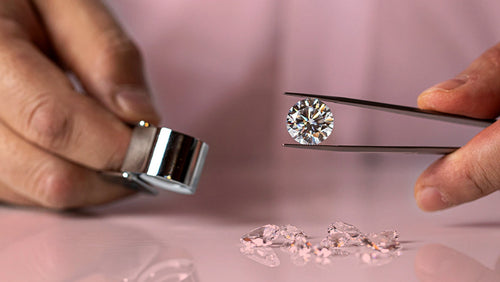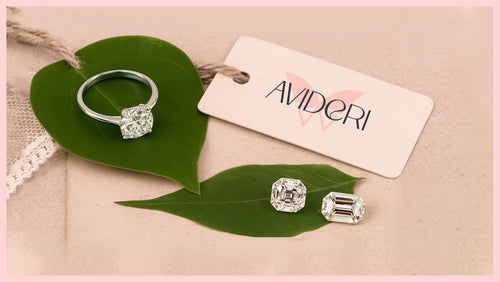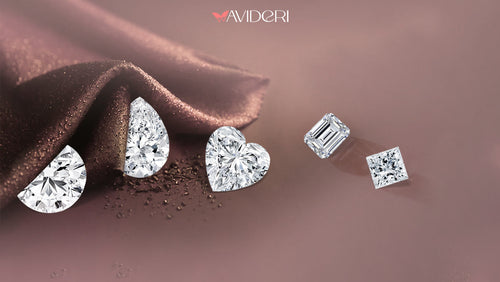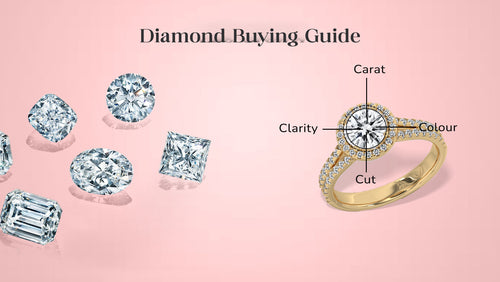Table Of Contents
- What’s the Difference Between Lab-Grown and Natural Diamonds?
- Lab Grown Diamonds vs Natural Diamonds: Pros and Cons
- Price Difference Between Lab-Grown and Natural Diamonds
- How Do They Look: Can You Tell the Difference?
- What's Better: Lab Grown Diamond or Natural for Your Engagement Ring?
- Final Thoughts: Which Diamond is Right for You?
"What’s better, lab-grown or natural?” It’s one of the most common questions couples ask when choosing an engagement ring (Lab Grown vs Natural Diamonds). With lab-grown diamonds becoming increasingly popular, many are now weighing their options more carefully than ever.
Lab-grown stones offer a modern, ethical alternative to natural diamonds but is one truly better than the other? Whether you're drawn to value, tradition, or sustainability, understanding the key differences can help you make the right choice for your love story.
What’s the Difference Between Lab-Grown and Natural Diamonds?

Natural diamonds are formed deep within the Earth over billions of years. They develop under intense heat and pressure, around 150–200 km below the surface, and are brought to the surface through volcanic activity. Each natural diamond is unique, shaped by geological conditions that cannot be replicated.
Lab-grown diamonds, on the other hand, are created in high-tech laboratories using advanced technology that mimics the natural process. These stones are formed in a matter of weeks using either High Pressure High Temperature (HPHT) or Chemical Vapour Deposition (CVD) methods.
Despite their different origins, lab-grown and natural diamonds are chemically, physically, and optically identical. Both rank 10 on the Mohs scale of hardness and have the same sparkle, brilliance, and structure. Even trained gemmologists often need specialised equipment to tell them apart.
Lab Grown Diamonds vs Natural Diamonds: Pros and Cons

When comparing lab-grown and natural diamonds, it’s important to weigh the unique advantages of each. Both are chemically and visually identical, but what they offer in terms of value, legacy, and sustainability can differ greatly.
Price Difference Between Lab-Grown and Natural Diamonds

The biggest difference between lab-grown and natural diamonds is the cost. On average, lab-grown diamonds are 40% to 60% less expensive than their natural counterparts. Making them a popular choice for budget-conscious buyers.
For instance, a 1-carat natural diamond with excellent cut, colour, and clarity can cost anywhere from $5,000 to $7,500, depending on certification and quality. A 1-carat lab-grown diamond with similar specifications typically ranges from $1,500 to $3,000, offering massive savings.
As carat size increases, the price gap widens. A 2-carat natural diamond might cost around $15,000 to $25,000, whereas a 2-carat lab-grown diamond of similar grade would usually fall between $3,500 and $6,000.
Even a high-end 3-carat natural diamond could exceed $40,000, while a lab-grown version of the same quality may only cost $7,000 to $12,000. While lab-grown diamonds offer exceptional value for size and appearance. Natural diamonds tend to hold their value better in the long run.
How Do They Look: Can You Tell the Difference?

To the naked eye, lab-grown and natural diamonds look the same. Both have the same sparkle, brilliance, and clarity when cut and graded to similar standards. They are made of pure carbon and share identical optical and physical properties. So unless you're a gemmologist with specialised equipment, you won’t be able to tell them apart.
Both types of diamonds are graded using the same 4Cs cut, colour, clarity, and carat weight by trusted labs like IGI or GIA. This ensures consistency and transparency in quality.
A common myth is that lab-grown diamonds look “fake” or less brilliant. In reality, a well-cut lab-grown diamond can appear just as vibrant and fiery as a natural one. Since they’re grown in controlled environments. Many lab grown stones are available in higher clarity grades with fewer natural inclusions.
What’s Better: Lab Grown Diamond or Natural for Your Engagement Ring?

If you want a larger stone, better clarity, and a more budget-friendly option, lab-grown diamonds are an excellent choice. They’re chemically and visually identical to natural diamonds, and you can often afford a higher quality stone for the same price. Plus, if sustainability is important to you, lab-grown is a responsible, modern option.
On the other hand, if you value rarity, tradition, and long-term resale or investment potential, a natural diamond might be the better fit. Some people prefer the idea of a stone that’s taken billions of years to form. Making it feel more symbolic and emotionally significant.
In the end, neither is better in every situation. It comes down to what matters most to you: the science and savings of lab-grown. The history and heritage of nature. Either way, both are beautiful, real diamonds perfect for a commitment that lasts a lifetime.
Final Thoughts: Which Diamond is Right for You?

At the end of the day, both lab-grown and natural diamonds are 100% real with the same beauty, brilliance, and durability. The key difference lies in how they’re formed and what they represent to you.
If your focus is on value, size, sustainability, or maximising your budget, lab-grown stones are the smart, modern choice. They offer exceptional beauty, larger sizes for less, and an eco-conscious alternative that aligns with today’s values. Compared to mined diamonds, lab-grown options deliver the same brilliance while making your investment go further.
There’s no wrong choice, only the one that best fits your personal values, lifestyle, and love story. Whether you go lab or natural, the diamond you choose will symbolise your commitment just the same.







